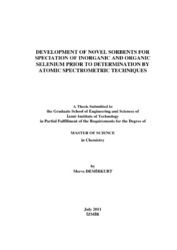Please use this identifier to cite or link to this item:
https://hdl.handle.net/11147/3136Full metadata record
| DC Field | Value | Language |
|---|---|---|
| dc.contributor.advisor | Eroğlu, Ahmet Emin | en |
| dc.contributor.author | Demirkurt, Merve | - |
| dc.date.accessioned | 2014-07-22T13:50:56Z | - |
| dc.date.available | 2014-07-22T13:50:56Z | - |
| dc.date.issued | 2011 | en |
| dc.identifier.uri | http://hdl.handle.net/11147/3136 | - |
| dc.description | Thesis (Master)--İzmir Institute of Technology, Chemistry, İzmir, 2011 | en |
| dc.description | Includes bibliographical references (leaves: 86-93) | en |
| dc.description | Text in English; Abstract: Turkish and English | en |
| dc.description | xi, 93 leaves | en |
| dc.description.abstract | Selenium is an essential trace element forplants, animals and the human body. Hovewer, its possible toxicity at high concentrations necessitates the development of analytical methods for theseparation and determination of the several forms of the element in environmental andbiological systems.In the first part of the study, commercially available and newly synthesized ceria (CeO2) and zirconia (ZrO2) were used for the sorption and speciation of inorganic selenium. Sorption parameterswere investigated for both sorbents for selenite (Se(IV)) and selenate (Se(VI))and the optimized parameters were determined to be 25°C for sorption temperature, 50.0 mg for sorbent amount, 30 min for shaking time for 20.0 mLof 100.0 μgL-1of both species. Therelease of Se(IV) and Se(VI) from the sorbents was realizedusing two eluents, 0.10 M NaOH and 0.10 NH4Cl, respectively. The accuracy of the proposedmethodology was verified with spike recovery tests for various water types spiked with 10.0 μgL-1and 100.0 μgL-1Se(IV) and Se(VI). Spike recovery values were determinedto range between 91% and 97% at 10.0 μgL-1level, and between 97% and 113% at100.0 μgL-1level, for ceria and zirconia, respectively. Moreover, the sorption efficiencies of the newly synthesized sorbentswere compared with those of the commercial sorbents.Ceria and zirconia were shown to be applied in the speciation of inorganic selenium. Sorption studies with nZVI-modified zirconia have demonstrated that the sorbent can be utilized for the speciation of inorganic and organoselenium; namely, Se(IV), Se(VI), Seleno-L-cystine and Seleno-DL-methionine. In the final part of the study, it was shown by column-type equilibration studies that alginate beads modified/immobilized with CeO2 or ZrO2through three different synthesis routes can be used for the sorption and speciation of inorganic selenium. | en |
| dc.language.iso | en | en_US |
| dc.publisher | Izmir Institute of Technology | en_US |
| dc.rights | info:eu-repo/semantics/openAccess | en_US |
| dc.subject.lcsh | Selenium | en |
| dc.subject.lcsh | Atomic spectroscopy | en |
| dc.subject.lcsh | Organoselenium compounds | en |
| dc.subject.lcsh | Sorbents | en |
| dc.title | Development of novel sorbents for speciation of inorganic and organik selenium prior to determination by atomic spectrometric techniques | en_US |
| dc.type | Master Thesis | en_US |
| dc.institutionauthor | Demirkurt, Merve | - |
| dc.department | Thesis (Master)--İzmir Institute of Technology, Chemistry | en_US |
| dc.relation.publicationcategory | Tez | en_US |
| item.languageiso639-1 | en | - |
| item.fulltext | With Fulltext | - |
| item.openairecristype | http://purl.org/coar/resource_type/c_18cf | - |
| item.openairetype | Master Thesis | - |
| item.grantfulltext | open | - |
| item.cerifentitytype | Publications | - |
| Appears in Collections: | Master Degree / Yüksek Lisans Tezleri | |
Files in This Item:
| File | Description | Size | Format | |
|---|---|---|---|---|
| T000945.pdf | MasterThesis | 6.05 MB | Adobe PDF |  View/Open |
CORE Recommender
Page view(s)
120
checked on Jul 22, 2024
Download(s)
104
checked on Jul 22, 2024
Google ScholarTM
Check
Items in GCRIS Repository are protected by copyright, with all rights reserved, unless otherwise indicated.